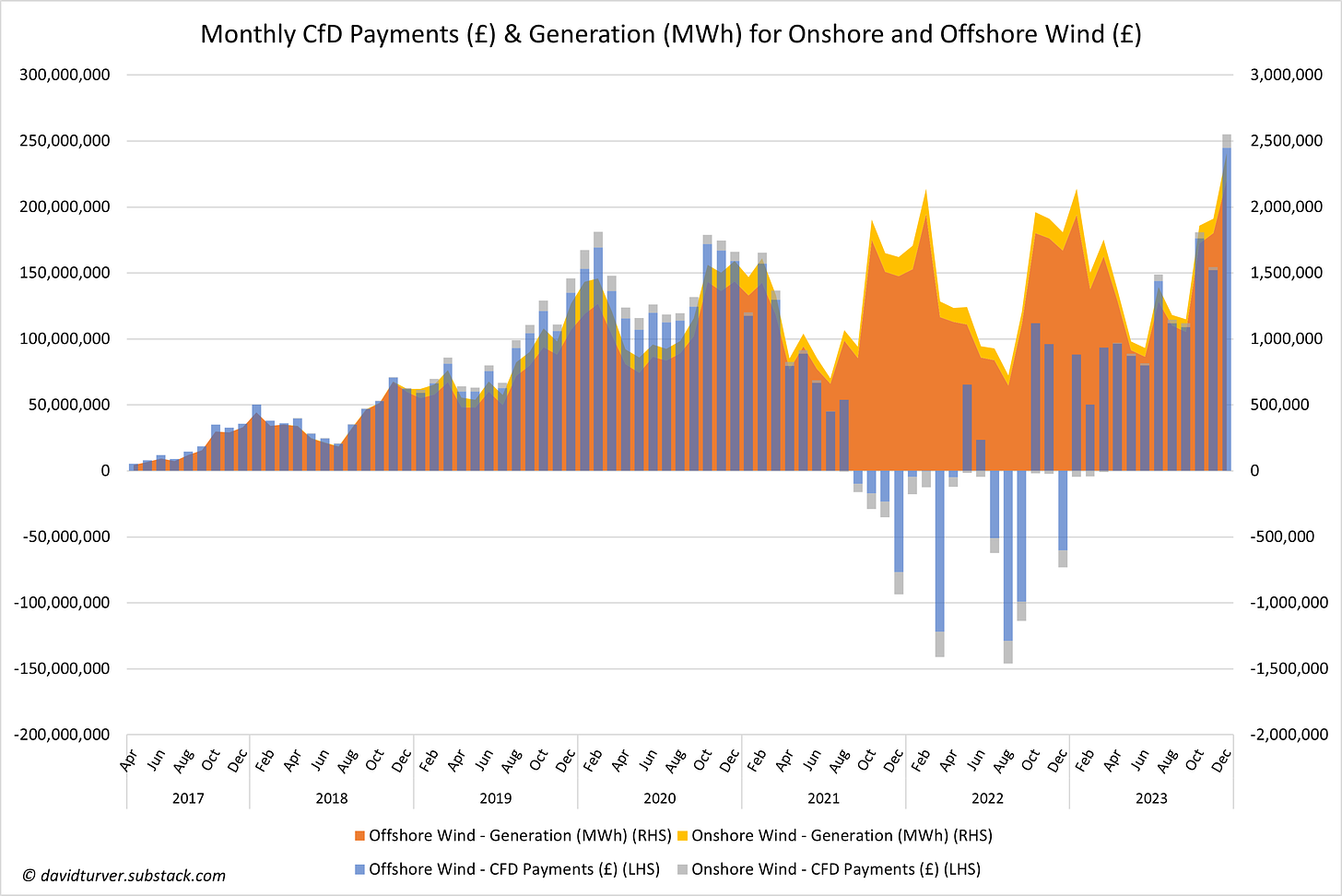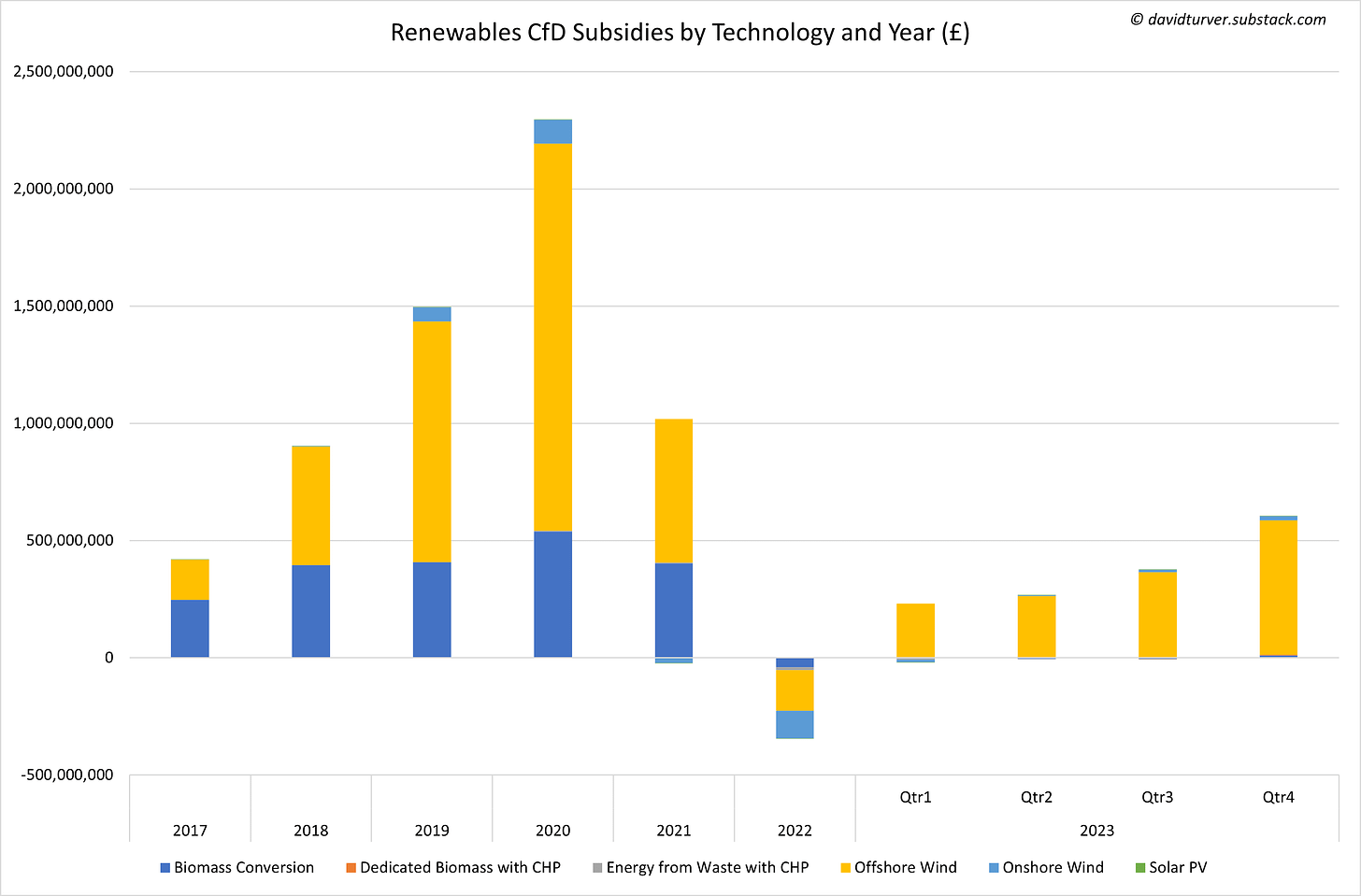Overnight, the Low Carbon Capture Company (LCCC) released the full data for renewables subsidies for December 2023. This is a short article that analyses the level of subsidies going to wind and other renewables.
Figure 1 shows the monthly subsidies for onshore (grey bars) and offshore (blue bars) wind since 2017. The orange area is offshore generation and the yellow area in onshore generation each month.
December saw the highest subsidies on record at over £255m. The next highest month was February 2020 at £188m. The months for highest generation tend to be December to February or March, so we might expect subsidies to continue at similar levels for some months to come.
The subsidies are paid to top-up the revenue of wind farm operators to the value of their Contract for Difference (CfD) when the market reference price is below the strike price of the CfD. Typically, the market reference price is set by gas-fired generation, so when the blue/grey bars are positive wind power is more expensive than gas. When the bars are negative, wind is cheaper than gas.
For some months in late-2021 and during 2022, gas was more expensive, so the operators had to pay back some of what they received so they did not get more than their strike price. However, gas prices have fallen since 2022 and CfD strike prices are index-linked and rise each year in line with inflation. So, even though gas prices are at the high end of their pre-crisis range, the gap between strike prices and gas prices has been rising again so subsidies have gone up.
However, as more wind farms have come online and taken up their CfD contracts, the amount of generation has also risen, so the average subsidy per MWh in 2023 was lower than that in 2020. If gas prices stay around their current level, we can expect another jump in subsidies from April 2024 as CfD strike prices index upwards again.
Figure 2 shows total CfD subsidies by year across all technologies.
The CfD subsidies for technologies other than wind are tiny in comparison. Overall subsidies for 2023 were the third highest on record at £1.45bn, just under the £1.5bn recorded in 2019. The subsidies for 2023 rose steadily each quarter, with the fourth quarter of 2023 coming in at £604m, close to the peak of £658m in the fourth quarter of 2020. It is therefore entirely possible that 2024 will run 2020 close to become the record year for subsidies.
Looking at 2022, the £346m paid back during that year is trivial in comparison to the overall £7.2bn paid in subsidies since 2017.
My conclusion from this is that renewables are not and never have been cheap. There was of course the anomaly of the gas supply crisis in 2022, exacerbated by Putin’s invasion of Ukraine. Gas prices are still elevated even though the crisis has abated, but subsidies are back to high levels and look set to increase. Do not let anyone tell you that renewables are cheap.
David Turver writes the Eigen Values Substack page, where this article first appeared.














To join in with the discussion please make a donation to The Daily Sceptic.
Profanity and abuse will be removed and may lead to a permanent ban.
Yep. He thinks the grown ups are back in charge and we are all children who need to be told what to do by the grown ups who are the ones that know best. That pretty much nails it.
And my hunch is that most of the population agrees.
86% of those who voted supported parties who either explicitly or implicitly stood for enlarging the role of the state or at least keeping it the same.
Even people on the political right are happy enough with people being told what to do as long as it’s stuff they agree with
It’s a stupid idea and is based on the ideology of hate that pervades Labour. It doesn’t make any sense and it will cost more to the State than it ever brings in. How are schools supposed to cope with tens of thousands of new children in the middle of the academic year? The Brain Dead voted in The Seriously Brain Dead.
It’s not about sense – it’s about punishing people for their ideology
Their hate goes back a long way.
I remember the hate of non-state run schools from Labour, around the mid-1960s. I remember it well because I couldn’t understand how passing a school entrance exam was such good news, yet the school I was in was beyond evil, according to nearly half the country, and nearly all of the Media.
My Dad said that, as well as the Secondary Modern and Grammar Schools there should have been technical schools, but it hadn’t happened, which did imply that Politics wasn’t full of grownups, even then! See Tripartite System heading, here:
https://en.m.wikipedia.org/wiki/Secondary_modern_school
I expect one group didn’t want to damage the exclusivity of the academics, and the other wanted to destroy any streaming by ability.
And, after 60 years, we have the very same problem at polytechnic/university level, if we can admit there is a problem.
The state should get out of education completely.
The state should also get out of the business of nudging behaviour through taxation, whether that is a sugar tax or tax on alcohol or tobacco.
Notice the government want to teach children how to spot “Fake News” and “Misinformation” while at the same time trying to force the end of private education. That will allow them to have all the children in State Schools where they can be freely indoctrinated.
This policy of the government isn’t just about envy of independent schools. It’s designed above all to strike at independent-of-the-state parents. This is because the marxo-fascist madleft, the advocates of the total-control state, believe that the state should own and control children, not parents. They intend to turn parents into the agents of the state inside the family. Thus, this policy is the beginning of the marxo-fascist war on independent parents, and everyone in our society still able to exercise what remains of our freedoms.
I’m sure the timing of the introduction of the tax in the academic mid-year is deliberate.
Parents will be more reluctant to make their kids change schools mid-year.
If families find they can just about cope with the additional costs during the winter-summer terms the government hopes more will dig that bit deeper and so continue to contribute to the fantasy £
1.71.5bn (and falling) tax takeBy creating the additional obstacle of changing schools mid-year the government hopes to phase in the increase in demand for state school places over a longer period.
Also holding out the possibility of punishing families (which can’t or won’t pay increased fees) for taking the kids away from independent school with no state school place allocated the government again hopes to manage the increase in demand.
In Bristol there at least 5000 children in Private schools. If they all went to the state system it would instantly collapse. It is already almost dead, with poor results. How would he fix this? I suppose a wave of a wand would build 3 new schools in 6 weeks! Dream on…
I find it difficult to understand why one man is being allowed to destroy an entire country? How is this possible in this day and age in a “democracy”?